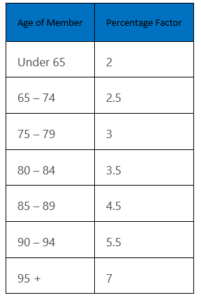Government stimulus package – Round 2
The government has announced a second round of stimulus measures totalling $66.1 billion.
The newly announced measures include:
- Boosting cash flow for employers:
- Tax free cash boost of up to $100,000 for business employers
- employers will receive a payment equal to 100 per cent of their PAYG withholding, with the maximum payment being $50,000 (increased from previously announced $25,000).
- The minimum payment/BAS credit is $10,000 or $20,000 over three BAS quarters
Eligibility
- Group turnover <$50 million
- Must have been an employer before 12 March 2020
How this will be paid
- Two-stage set of payments.
- Across March-June BASs: Payment/credit for 100% of PAYG withholding (minimum $10,000 up to $50,000).
- Across June-September BASs: Additional payment equal to total of above.
Example 1 – Sean’s Hairdresser Salon
Sean owns a hairdresser’s salon on the Gold Coast. He employs 12 hairdressers, with average salary of $50,000 per year. Sean reports withholding of $8,788 for his employees in each of his monthly BAS.
Under the Government’s changes, Sean will be eligible to receive the payments on lodgment of his relevant BAS.
Sean’s business will receive:
- A credit of $26,364 for the March period, equal to 300 per cent of his total withholding.
- A credit of $8,788 for the April period.
- A credit of $8,788 for the May period.
- A credit of $6,060 for the June period, before he reaches the $50,000 cap.
Sean will also receive an additional payment of $12,500 for the June period, equal to 25 per cent of his total Boosting Cash Flow for Employers payments.
- An additional payment of $12,500 for the July period, equal to 25 per cent of his total Boosting Cash Flow for Employers payments.
- An additional payment of $12,500 for the August period, equal to 25 per cent of his total Boosting Cash Flow for Employers payments.
- An additional payment of $12,500 for the September period, equal to 25 per cent of his total Boosting Cash Flow for Employers payments.
Under the previously announced Boosting Cash Flow for Employers measure, Sean’s business would have received a total payment of $25,000.
Under the Government’s enhanced Boosting Cash Flow for Employers measure, Sean’s business will receive $100,000. This is an additional $75,000 to support his business.
Example 2 – Tim’s Courier Run
Tim owns and runs a small paper delivery business in Melbourne, and employs two casual employees who each earn $10,000 per year. In his quarterly BAS, Tim reports withholding of $0 for his employees as they are under the tax-free threshold.
Under the Government’s changes, Tim will be eligible to receive the payment on lodgment of his BAS.
Tim’s business will receive:
- A credit of $10,000 for the March quarter, as he pays salary and wages but is not required to withhold tax.
- An additional payment of $5,000 for the June quarter, equal to 50 per cent of his total Boosting Cash Flow for Employers payments.
- An additional payment of $5,000 for the September quarter, equal to 50 per cent of his total Boosting Cash Flow for Employers payments.
If Tim begins withholding tax for the June quarter, he would need to withhold more than $10,000 before he receives any additional payment.
Under the previously announced Boosting Cash Flow for Employers measure, Tim’s business would have received a total payment of $2,000.
Under the Government’s enhanced Boosting Cash Flow for Employers measure, Tim’s business will receive $20,000. This is an additional $18,000 to support his business.
- Temporary relief for financially distressed businesses:
- Relief for directors from personal liability for trading while insolvent (except in cases of dishonesty or fraud).
- Increased threshold (from $2,000 to $20,000) at which creditors can issue a statutory demand, and extended response deadline.
- Increased threshold for creditor-initiated bankruptcy.
- ATO open to easier payment terms for outstanding tax debts; lighter approach to withholding enforcement, Director Penalty Notices.
- Treasurer to be given power to modify or provide relief from obligations under the Corporations Act.
- The above measures will apply for six months.
- Supporting the flow of credit:
- Small-to-medium enterprise (SME) business loan guarantee scheme:
- The government will provide a guarantee of 50% to eligible lenders of unsecured loans to be used for working capital.
- Maximum loan facility of $250,000 per borrower.
- Term of up to three years, with initial six-month repayment holiday.
- For businesses with turnover up to $50 million
- Subject to lenders’ credit assessment processes, with the expectation of looking through this short-term difficult period.
- Scheme to support $40 billion of lending (ie, $20 billion guaranteed).
- Cut red tape, with a six-month exemption from responsible lending obligations for lenders to SMEs.
- $15 billion for the Australian Office of Financial Management to invest in structured finance markets used by smaller lenders.
- RBA’s $90 billion term funding facility for the banking industry, to put downward pressure on borrowing costs.
- APRA temporarily easing expectations for banks’ capital ratios.
- Earlier access to superannuation:
Individuals in financial distress due to the coronavirus can access up to $10,000 of their superannuation – one time – before 1 July 2020.
- Can access up to a further $10,000 – again, one time – from 1 July for approximately another three months.
- Tax free, and will not affect Centrelink or Veterans’ Affairs payments.
Eligibility
To apply for early release you must satisfy any one or more of the following requirements:
- you are unemployed; or
- you are eligible to receive a job seeker payment, youth allowance for jobseekers, parenting payment (which includes the single and partnered payments), special benefit or farm household allowance; or
- on or after 1 January 2020:
- you were made redundant; or
- your working hours were reduced by 20 per cent or more; or
- if you are a sole trader — your business was suspended or there was a reduction in your turnover of 20 per cent or more.
How to Apply
- Apply through myGov, from mid-April.
- Once the ATO has processed the application and confirmed the individual’s eligibility, they will provide both the individual and their superannuation fund with a determination.
- It is not yet clear how long it will take for the ATO to Process an application and the fund to make the payment to the inidividual
Separate arrangements will apply if you are a member of a self-managed superannuation fund.
While we understand the eligibility rules for SMSF members will be the same as for members of non-SMSFs, separate arrangements are being made and there may be a different process to follow when moneys are to be released from an SMSF. We will provide further guidance on the application process for SMSF members once made available in due course.
At this stage we will be able to prepare the fund documentation to evidence the withdrawal of monies under this new condition of release
Note that anyone who simply withdraws money from their SMSF now, or even after mid April but does not follow the right process, will be subject to the usual rules. This could be substantial tax and other penalties – it is vital to wait until the new rules are in place.Further guidance to follow.
ATO Fact Sheet (https://treasury.gov.au/sites/default/files/2020-03/Fact_sheet-Early_Access_to_Super_1.pdf)
- Support for retirees:
- The minimum pension requirements for 2019/20 and 2020/21 will be re-set to half the normal rates and there will be changes to the deeming rates used to calculate an individual’s income for a range of important government benefits (including the age pension).
- The revised rates for the 2019/20 and 2020/21 years will be as follows:
- there will not be a mechanism to return surplus pension payments if a pensioner has already drawn more than their reduced minimum. It may, however, be possible for some to recontribute the surplus (if they are eligible to contribute and the amount will be within their contribution caps).
- Income support for individuals:
- Temporary additional $550 per fortnight supplement for new and existing recipients of certain payments:
- Youth Allowance
- Jobseekeer
- Parenting Payment
- Farm Household Allowance
- Sole trader/Self employed applying for the above benefits
- Available for the next six months initially commencing 27 April 2020
- Payments to support households:
- The Mark I one-off $750 payment over March-April to pensioners, social security, veteran and other income support recipients will be followed up by a second $750 payment in July (except those eligible for above supplement).
These measures are in addition to those on our newsletter dated 18 March 2020.



